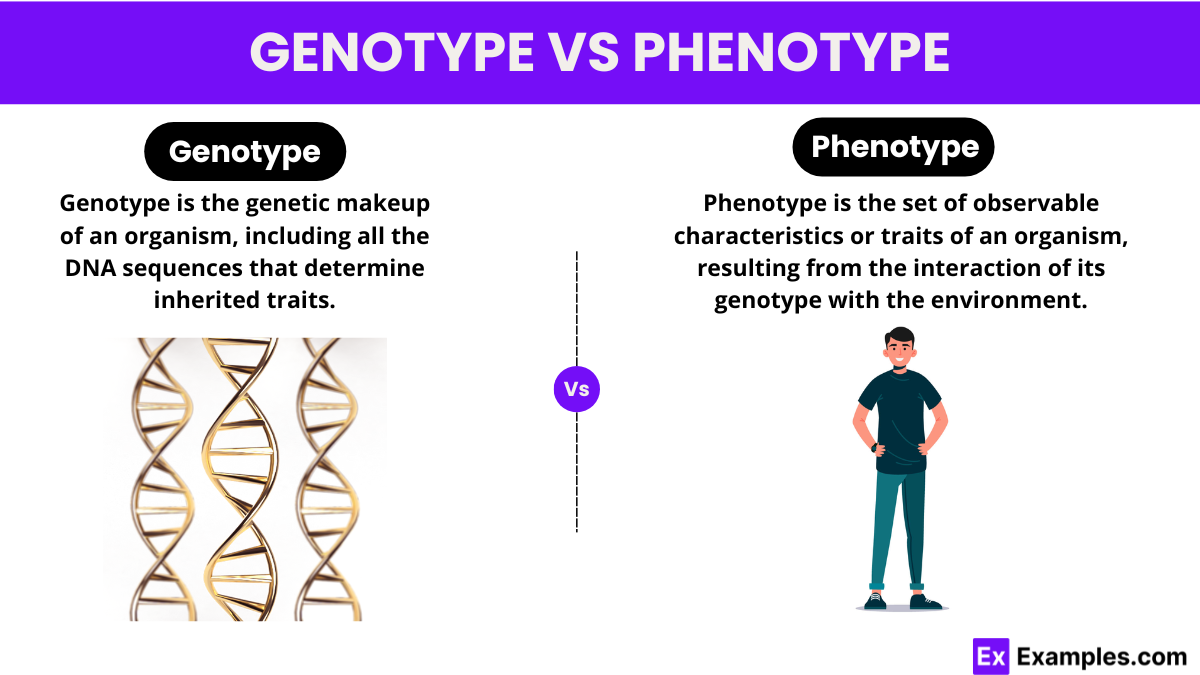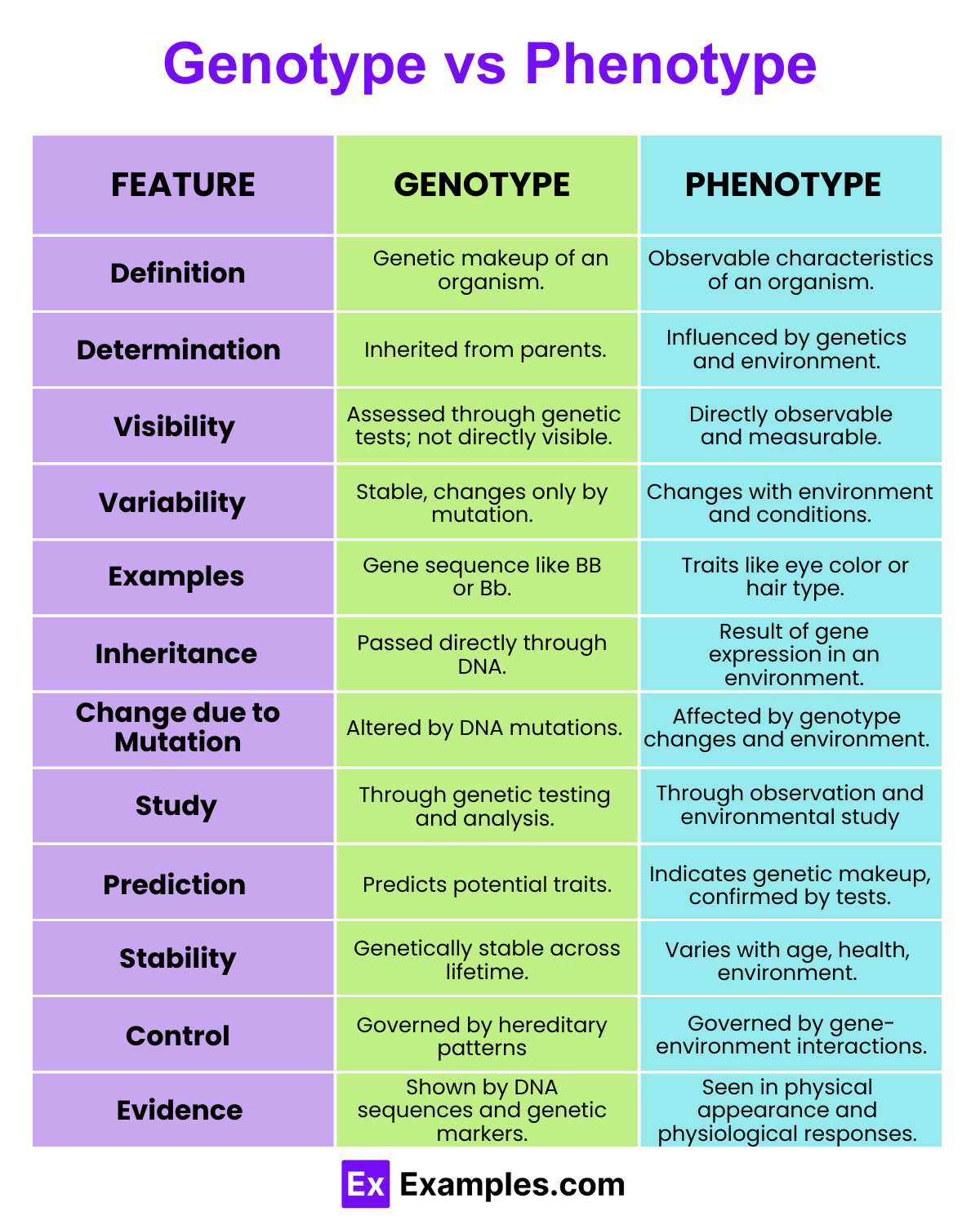What is the definition of \"genotype\"?
The physical appearance of an organism
The genetic makeup of an organism
The behavior of an organism
The environment of an organism


Genotype refers to an individual’s unique DNA sequence, specifically the variants inherited from each parent for a particular gene. In contrast, phenotype is the observable expression of the genotype, shaped by the interaction between genetic makeup and environmental factors. The relationship between genotype and phenotype is complex and not always predictable, often leading to variations in the manifestation of genetic conditions.
Factors such as reduced penetrance and variable expressivity contribute to these discrepancies. Reduced penetrance means that not all individuals with a genetic variant will exhibit the associated condition, influenced by a mix of genetic, environmental, and lifestyle factors. For instance, familial cancer syndromes often show reduced penetrance, complicating risk predictions for relatives.
A genotype is the specific combination of alleles an individual inherits for a particular gene, located at a fixed position on a chromosome known as a locus. Genes, sections of DNA, encode traits through the arrangement of nucleotides—each consisting of a phosphate group, a sugar, and a base. These genes can exist in various forms, or alleles, which differ between organisms. In diploid organisms, the genotype can be homozygous, inheriting two identical alleles, or heterozygous, inheriting two different alleles at the locus. The expression of these alleles, whether dominant or recessive, ultimately determines the traits manifested by the individual.
A phenotype encompasses all the observable characteristics of an organism, influenced by both its genetic makeup (genotype) and various external factors. Unlike the genotype, which parents directly inherit, the phenotype does not solely derive from parental genes. It results from the interplay between the genotype and additional elements such as epigenetic modifications, environmental conditions, and lifestyle choices. This complex interaction ensures that even organisms with similar genotypes can display significantly different phenotypes.

| Aspect | Genotype | Phenotype |
|---|---|---|
| Definition | Genotype refers to the genetic makeup of an organism; the specific alleles present at a given locus. | Phenotype describes the observable physical or biochemical characteristics of an organism, as determined by both genetic makeup and environmental influences. |
| Determination | Determined by the genes inherited from the parents. | Determined by the genotype and environmental factors, including diet, lifestyle, and climate. |
| Visibility | Not directly observable; can only be assessed through genetic tests. | Directly observable traits such as height, skin color, and eye color, or measurable characteristics like blood type and enzyme activity. |
| Variability | Remains constant throughout life. Genes received at conception are unchanged. | Can change over time. For instance, weight and skin tanning can vary significantly due to environmental factors. |
| Examples | A person carrying a recessive allele for cystic fibrosis, which might not be expressed. | A person actually exhibiting symptoms of cystic fibrosis due to the presence of two recessive alleles. |
| Inheritance | Passed down from parents to offspring through genes. Each parent contributes half of the offspring’s genotype. | Not inherited directly. While genetic potential is inherited, the phenotype is the expression of that potential under particular environmental conditions. |
| Change due to Mutation | Can change if a mutation occurs in the DNA sequence. Such changes can be inherited. | Can be affected by mutations in the genotype, but also by new environmental conditions; not all changes in phenotype are inheritable. |
| Study | Studied in genetics through breeding experiments, DNA sequencing, and molecular biology techniques. | Studied through observations of physical traits, physiological responses, and behaviors in various environmental contexts. |
| Prediction | Genotype can be used to predict possible phenotypes but does not guarantee specific outcomes due to environmental influences. | Phenotype can give clues about genotype but cannot reveal exact genetic composition without genetic testing. |
Genotype refers to an organism’s genetic makeup, while phenotype is the observable expression of those genes.
Phenotype example: blue eye color. Genotype example: BB or Bb genes for eye color.
AA is a genotype, representing a specific set of alleles in an organism’s DNA.
The three genotypes are homozygous dominant (AA), heterozygous (Aa), and homozygous recessive (aa). Each represents different genetic combinations from parental alleles.
Text prompt
Add Tone
10 Examples of Public speaking
20 Examples of Gas lighting
What is the definition of \"genotype\"?
The physical appearance of an organism
The genetic makeup of an organism
The behavior of an organism
The environment of an organism
Which of the following is an example of a phenotype?
The sequence of DNA in a gene
The height of a plant
The number of chromosomes
The arrangement of genes on a chromosome
If a pea plant has a genotype of Tt for height, what is its phenotype?
It is tall
It is short
It is medium height
It cannot be determined
Which of the following best describes the relationship between genotype and phenotype?
Genotype directly determines phenotype
Phenotype directly determines genotype
Genotype influences phenotype, but environment also plays a role
Phenotype has no connection to genotype
What term describes the genetic variations found in different individuals of a species?
Phenotypic variation
Genotypic variation
Environmental variation
Behavioral variation
In humans, the presence of freckles is a phenotype. If having freckles (F) is dominant over not having freckles (f), what is the genotype of a person without freckles?
FF
Ff
ff
Ff or ff
What is the term for the observable physical and physiological traits of an organism?
Genotype
Phenotype
Gene pool
Genome
Which factor can modify the phenotype of an organism without altering its genotype?
Mutations
Genetic recombination
Environmental influences
Natural selection
What does a heterozygous genotype look like for a gene with two alleles, A and a?
AA
aa
Aa
AA or aa
Which of the following would be a genotypic ratio for a monohybrid cross between two heterozygous individuals (Tt x Tt)?
3:1
1:2:1
9:3:3:1
1:1
Before you leave, take our quick quiz to enhance your learning!

